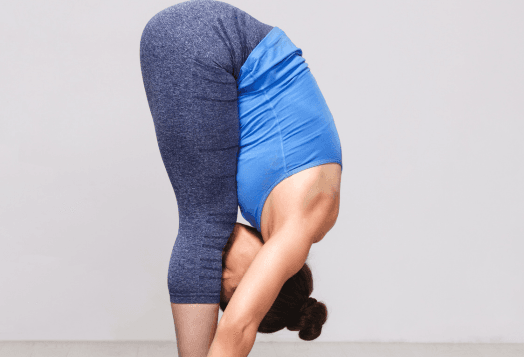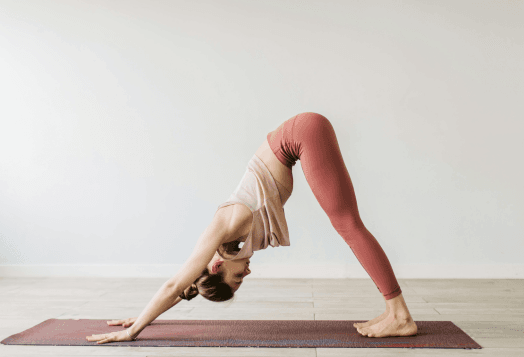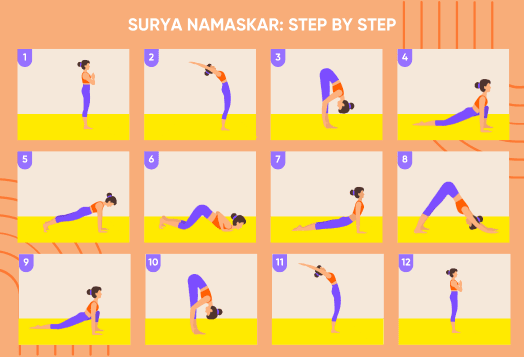Woke up feeling heavy, foggy, or stiff? You’re not alone. The early hours often come with tight muscles and low energy, making it hard to step into your day with purpose. That’s exactly why Surya Namaskar yoga has stood the test of time. Learning how to do sun salutation can reset your mood, unlock tension, and gently activate your metabolism, all in under 15 minutes.
So let's dive right in.
Origins & Significance of Surya Namaskar
Surya Namaskar, also known as the sun salutation, is a foundational practice in many schools of yoga. The name itself reflects deep respect: ‘Surya’ means sun, and ‘Namaskar’ translates to salute. Practising this sequence is a spiritual expression of gratitude to the sun, our primary source of energy and life.
Each posture in the sun salutation sequence is synchronised with the breath, honouring the cycles of nature and our inner rhythm. In yogic philosophy, the sun represents the solar plexus (Manipura Chakra), the core of vitality and intuition. Stimulating this energy centre through Surya Namaskar enhances overall well-being.
Research published in the Journal of Ayurveda and Integrative Medicine suggests that regular practice enhances cardiovascular endurance, balances the endocrine system, and supports both physical and mental well-being. The importance of Surya Namaskar goes beyond fitness; it's a powerful lifestyle enhancer.
Step-by-Step Sun Salutation Sequence
The 12-step sequence of Surya Namaskar is a beautifully coordinated flow of asanas that invigorate the entire body. Let’s explore the perfect surya namaskar sequence in detail:
1. Pranamasana (Prayer Pose)

Begin by standing upright with your feet together and palms joined at your heart. Breathe evenly and cultivate awareness. This is your moment to centre yourself.
2. Urdhva Hastasana (Raised Arms Pose)

Inhale deeply as you sweep your arms overhead. Gently arch your back and stretch upwards, lifting your ribcage and engaging your core.
3. Uttanasana (Standing Forward Bend)

Exhale and hinge at the hips, keeping the spine long as you fold forward. Let your head relax toward your knees, stretching the hamstrings.
4. Ashwa Sanchalanasana (Equestrian Pose)
Inhale as you step the right leg back, lowering the knee to the mat. Keep your left foot grounded, with your fingertips touching the floor, and keep your chest open.

5. Chaturanga Dandasana (Four-Limbed Staff Pose)

Exhale and step the left leg back into a high plank. Engage the core, align your shoulders above your wrists, and lower into a strong, straight line.
6. Ashtanga Namaskara (Eight-Limbed Pose)

Gently lower your knees, chest, and chin to the mat while keeping the hips lifted. Eight parts of the body touch the ground: feet, knees, hands, chest, and chin.
7. Bhujangasana (Cobra Pose)

Inhale and slide forward, lifting the chest with shoulders relaxed, a movement that also supports yoga for glowing skin by boosting circulation. Press through your palms while keeping your elbows close to your body. Avoid straining the lower back.
8. Adho Mukha Svanasana (Downward-Facing Dog)

Exhale and lift the hips into an inverted 'V' shape. Lengthen your spine and push your heels toward the floor. This pose strengthens the arms, shoulders, and calves.
9. Ashwa Sanchalanasana

Inhale, bring the right foot forward between the hands and repeat the equestrian pose, mirroring the earlier step.
10. Uttanasana

Exhale and step the left foot forward. Fold deeply from the hips and allow the spine to release.
11. Urdhva Hastasana

Inhale as you rise, stretching the arms overhead and arching slightly.
12. Pranamasana

Exhale and return to the prayer pose, bringing hands to the heart centre.
Benefits of Practising Surya Namaskar
If you're wondering about the benefits of Surya Namaskar, the list is long and transformative. From physical vitality to emotional equilibrium, this full-body flow covers it all.
Cardiovascular Fitness: The continuous flow of movements elevates heart rate, enhancing endurance.
Boosts Metabolic Rate: It activates the solar plexus, accelerating metabolism and aiding digestion, making it a key component in weight loss yoga for beginners.
Flexibility & Mobility: It stretches every major muscle group, improving joint mobility and posture.
Hormonal Balance: The sequence stimulates endocrine glands, especially the thyroid, adrenals, and pancreas.
Mental Clarity: Breath-focused flow calms the nervous system, reducing anxiety and enhancing focus.
Regularly practising Surya Namaskar yoga offers a myriad of physical and mental benefits
Best Time and Frequency to Practice
For best results, perform Surya Namaskar early in the morning on an empty stomach. This aligns your body with the sun’s energy, enhancing effectiveness.
Ideal Frequency: 6-10 rounds per session.
Best Days: Daily is optimal, but even 4-6 times a week yields notable benefits.
If you’re short on time, even a 10-minute morning yoga ritual with 3–6 rounds can energise your entire day.
Common Mistakes to Avoid
Even seasoned yoga practitioners can unknowingly develop habits that disrupt the harmony of the sun salutation yoga flow. Here are some of the most common mistakes and how to avoid them:
Rushing Through the Sequence: Surya Namaskar is not a race. Performing it too quickly can lead to poor posture and disconnected breath. Slow down and savour each movement.
Ignoring Breath Coordination: Each pose in the 12-step sequence has a breath cue. Skipping or holding your breath breaks the rhythm and reduces the energising effect of the practice.
Misaligned Spine: In poses like Chaturanga Dandasana or Adho Mukha Svanasana, improper alignment, such as arching too much or rounding the back, can lead to strain or injury. Focus on keeping a neutral spine.
Skipping Warm-Up and Cool-Down: While Surya Namaskar itself is a great warm-up, your body still needs gentle joint mobility exercises beforehand. Post-practice relaxation, like Savasana, helps integrate the benefits.
Being mindful of these elements ensures you cultivate not just a safer, but a more transformative experience every time you step onto the mat.
Embrace the Power of Sun Salutation
Surya Namaskar yoga can be as gentle or as invigorating as you make it. As you grow more comfortable with the sequence, you’ll notice improvements in not just your strength and flexibility, but also in your focus, resilience, and inner calm.
Mastering how to do Surya Namaskar is about showing up for yourself each day with mindfulness and intention. Start small, stay consistent with yoga trainers, and breathe deeply, because the real transformation begins not when you perfect the pose, but when you fully connect with it.




